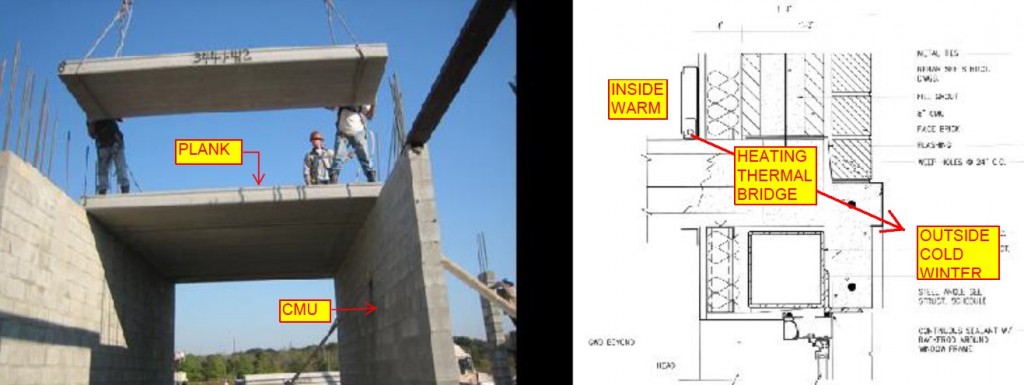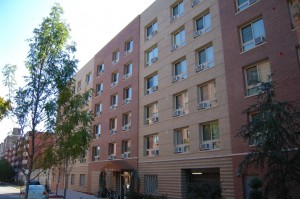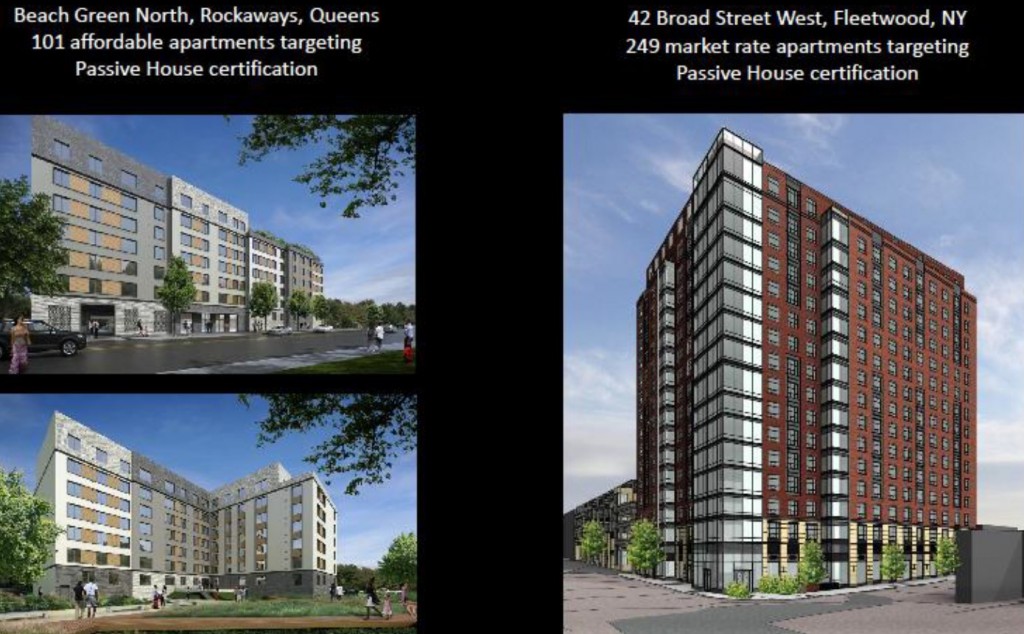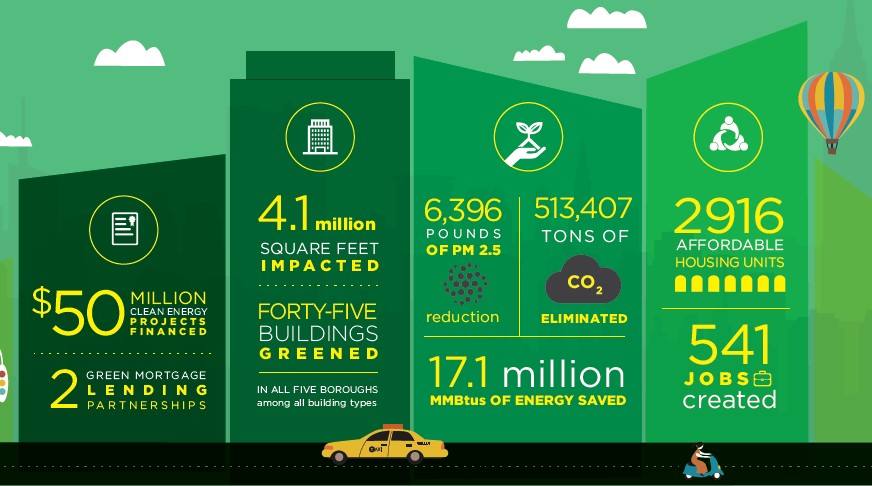September 10, 2015
by Jaime Alvarez
Two seasoned building professionals and a financier came together on Wednesday, August 19th at the GreenHomeNYC August forum held at the Hafele showroom to share their experiences regarding the economic value of green building with a full room of over 50 curious attendees. The presentations emphasized that with attention to detail, green buildings can be built affordably.
Steve Bluestone of The Bluestone Organization: Making green building cost competitive
Affordable housing developer, Steven Bluestone, began the discussion showing how through years of practice and commitment to constant improvement his firm has left behind stagnant building practices and forged ahead past code requirements with a simpler building process which delivers more efficient buildings with significant cost savings to tenants.
For over fifty years, small to medium multi-family housing has been built using concrete masonry unit, “cinder block,” structural walls and planks for flooring and roofing. The buildings would be structurally sound, but energy efficiency suffered as a result of minimal insulation, air sealing, and “thermal bridges”— where conductive material such as concrete is exposed to outdoor weather drawing in cold temperature indoors during winter, and warmer temperatures in summer, raising heating and cooling costs.

To address these issues
The Bluestone Organization started experimenting with the use of insulated concrete forms (ICFs), two thick sheets of insulating foam held in place about eight inches apart by plastic connectors. These ICFs are stacked and connected like Lego blocks to create the concrete wall formwork, fitted with reinforcing steel rebar rods, and finally filled with poured concrete. After the concrete has structurally set, floor and roof planks can be laid. The result is installation of a robust weather barrier, structure, and interior furring by a single work crew, adding to the competitiveness of this method versus conventional construction.

The impact of this innovation can be experienced through added comfort, construction quality, resiliency, and most significantly for an affordable housing developer, reduced utility costs. As an example, a typical one bedroom apartment in a six story building can be heated an entire winter for about $140, compared to $990 for a similar sized older apartment/building, an extraordinary 85% in savings.

After perfecting these new methods, the Bluestone Organization plans to continue to innovate by reaching for
Passive House Certification in new developments, a standard demanding a 90% improvement in performance when compared to existing building stock, a 70% improvement from current code requirements. Additional initiatives include the use of rooftop solar with battery backup during high demand periods to reduce electrical costs as well as separately metering hot/cold water then billing to the individual apartment, which can result in 25% savings by informing of consumption.
 Chris Benedict: Identifying new value
Chris Benedict: Identifying new value
As a veteran architect devoted to delivering high performing green buildings for the same price as typical construction for the past 20 years, Chris Benedict has designed, built, and monitored enough buildings to be able to identify previously unrecognized economic benefits of green buildings which she shared with the audience:
More insulation means less HVAC units: A green building typically requires a significantly upgraded building envelope relative to existing building code. Cost of a better envelope can be offset by the resulting lower energy use as well as smaller heating and cooling equipment, often the most costly and complex components in a building.
Rooftop boilers are simply resilient: While most boilers are typically installed in cellars and basements due to ease of construction, Ms. Benedict has made it her standard practice to install them on the roof of her buildings. Installing a boiler on the roof does not require a chimney, it is a resiliency measure especially in in flood-prone areas with cellars, and delivers higher energy efficiency. To emphasize this point, a cellar/basement can flood not only in FEMA recognized flood zones due to incoming floodwaters, but also further inland due to water seepage caused by increased water pressure in saturated soil. This is especially of concern in multiple low-lying areas such as lower eastern Manhattan and Brooklyn.
Keeping out the bedbugs: Compartmentalizing each apartment unit within its own thermal envelope results in superior energy efficiency and thermal comfort. As an added side benefit also it quarantines the unit in case of a costly bed bug infestation. The bed bugs will not travel across units as easily and spread throughout the building.
Preveting parapetitis: Typically parapets are subject to different temperature exposures from their supporting walls below, which are partially heated by the interior space. This variation in temperatures can lead to costly masonry repair to keep the parapet in place from falling. An insulated parapet exposes structural masonry to less weather fluctuations, requiring less repair.
Total building makeover: Retrofitting a building with an insulated facade can give the existing property a fresh new look, increasing building value.
In closing her segment Ms. Benedict presented images of her
latest project on West 153rd. St, where she emphasized the distilled “naked value” of such a project. This can be broken down into living as an activist by promoting energy efficiency, independence, and a reduced carbon footprint through the simple acts of daily residential life.
Posie Constable of NYCEEC: Putting up greenbacks for green building
To round out the discussion Posie Constabe, head of business development at the
New York City Energy Efficiency Corporation (NYCEEC), introduced her organization as one providing a broad array of financial solutions targeted towards green building for energy efficiency renovations, upgrades, renewables, and new construction. The organization’s objective is to remove monetary roadblocks towards improving the energy efficiency of building stock within the local area. NYCEEC can fund 100% of project costs via loans up to $6 million, can partner with all local incentive providers, and most importantly, will allow clients to use energy cost savings to pay back the provided loan.
Since it’s inception in 2011 NYCEEC has:
Funded $50 million in clean energy projects
Impacted 4.1 million square feet across 45 buildings
Eliminated 513,407 tons of CO2
Built or improved 2,916 affordable housing units
Created 541 jobs

One of the project highlights presented included the first Passive House project in Manhattan, a 6 unit condominium building, for which NYCEEC provided 50% of the project funding and functioned as the lead lender. Such an example emphasizes NYCEEC’s capacity to provide funding to realize an innovative project and identify value where a more conventional lender may have been reluctant to provide assistance.
While currently limited to working within the New York City area, NYCEEC seeks to provide financial impact wherever a feasible project may present itself.
 A green home for all
A green home for all
We would like to thank all our speakers for enlightening the audience with their direct experience, showing us that a green home can be cost competitive, affordable, and attainable for the public.
 To address these issues The Bluestone Organization started experimenting with the use of insulated concrete forms (ICFs), two thick sheets of insulating foam held in place about eight inches apart by plastic connectors. These ICFs are stacked and connected like Lego blocks to create the concrete wall formwork, fitted with reinforcing steel rebar rods, and finally filled with poured concrete. After the concrete has structurally set, floor and roof planks can be laid. The result is installation of a robust weather barrier, structure, and interior furring by a single work crew, adding to the competitiveness of this method versus conventional construction.
To address these issues The Bluestone Organization started experimenting with the use of insulated concrete forms (ICFs), two thick sheets of insulating foam held in place about eight inches apart by plastic connectors. These ICFs are stacked and connected like Lego blocks to create the concrete wall formwork, fitted with reinforcing steel rebar rods, and finally filled with poured concrete. After the concrete has structurally set, floor and roof planks can be laid. The result is installation of a robust weather barrier, structure, and interior furring by a single work crew, adding to the competitiveness of this method versus conventional construction.
 The impact of this innovation can be experienced through added comfort, construction quality, resiliency, and most significantly for an affordable housing developer, reduced utility costs. As an example, a typical one bedroom apartment in a six story building can be heated an entire winter for about $140, compared to $990 for a similar sized older apartment/building, an extraordinary 85% in savings.
The impact of this innovation can be experienced through added comfort, construction quality, resiliency, and most significantly for an affordable housing developer, reduced utility costs. As an example, a typical one bedroom apartment in a six story building can be heated an entire winter for about $140, compared to $990 for a similar sized older apartment/building, an extraordinary 85% in savings.
 After perfecting these new methods, the Bluestone Organization plans to continue to innovate by reaching for Passive House Certification in new developments, a standard demanding a 90% improvement in performance when compared to existing building stock, a 70% improvement from current code requirements. Additional initiatives include the use of rooftop solar with battery backup during high demand periods to reduce electrical costs as well as separately metering hot/cold water then billing to the individual apartment, which can result in 25% savings by informing of consumption.
After perfecting these new methods, the Bluestone Organization plans to continue to innovate by reaching for Passive House Certification in new developments, a standard demanding a 90% improvement in performance when compared to existing building stock, a 70% improvement from current code requirements. Additional initiatives include the use of rooftop solar with battery backup during high demand periods to reduce electrical costs as well as separately metering hot/cold water then billing to the individual apartment, which can result in 25% savings by informing of consumption.
 Chris Benedict: Identifying new value
As a veteran architect devoted to delivering high performing green buildings for the same price as typical construction for the past 20 years, Chris Benedict has designed, built, and monitored enough buildings to be able to identify previously unrecognized economic benefits of green buildings which she shared with the audience:
More insulation means less HVAC units: A green building typically requires a significantly upgraded building envelope relative to existing building code. Cost of a better envelope can be offset by the resulting lower energy use as well as smaller heating and cooling equipment, often the most costly and complex components in a building.
Rooftop boilers are simply resilient: While most boilers are typically installed in cellars and basements due to ease of construction, Ms. Benedict has made it her standard practice to install them on the roof of her buildings. Installing a boiler on the roof does not require a chimney, it is a resiliency measure especially in in flood-prone areas with cellars, and delivers higher energy efficiency. To emphasize this point, a cellar/basement can flood not only in FEMA recognized flood zones due to incoming floodwaters, but also further inland due to water seepage caused by increased water pressure in saturated soil. This is especially of concern in multiple low-lying areas such as lower eastern Manhattan and Brooklyn.
Keeping out the bedbugs: Compartmentalizing each apartment unit within its own thermal envelope results in superior energy efficiency and thermal comfort. As an added side benefit also it quarantines the unit in case of a costly bed bug infestation. The bed bugs will not travel across units as easily and spread throughout the building.
Preveting parapetitis: Typically parapets are subject to different temperature exposures from their supporting walls below, which are partially heated by the interior space. This variation in temperatures can lead to costly masonry repair to keep the parapet in place from falling. An insulated parapet exposes structural masonry to less weather fluctuations, requiring less repair.
Total building makeover: Retrofitting a building with an insulated facade can give the existing property a fresh new look, increasing building value.
In closing her segment Ms. Benedict presented images of her latest project on West 153rd. St, where she emphasized the distilled “naked value” of such a project. This can be broken down into living as an activist by promoting energy efficiency, independence, and a reduced carbon footprint through the simple acts of daily residential life.
Posie Constable of NYCEEC: Putting up greenbacks for green building
To round out the discussion Posie Constabe, head of business development at the New York City Energy Efficiency Corporation (NYCEEC), introduced her organization as one providing a broad array of financial solutions targeted towards green building for energy efficiency renovations, upgrades, renewables, and new construction. The organization’s objective is to remove monetary roadblocks towards improving the energy efficiency of building stock within the local area. NYCEEC can fund 100% of project costs via loans up to $6 million, can partner with all local incentive providers, and most importantly, will allow clients to use energy cost savings to pay back the provided loan.
Since it’s inception in 2011 NYCEEC has:
Funded $50 million in clean energy projects
Impacted 4.1 million square feet across 45 buildings
Eliminated 513,407 tons of CO2
Built or improved 2,916 affordable housing units
Created 541 jobs
Chris Benedict: Identifying new value
As a veteran architect devoted to delivering high performing green buildings for the same price as typical construction for the past 20 years, Chris Benedict has designed, built, and monitored enough buildings to be able to identify previously unrecognized economic benefits of green buildings which she shared with the audience:
More insulation means less HVAC units: A green building typically requires a significantly upgraded building envelope relative to existing building code. Cost of a better envelope can be offset by the resulting lower energy use as well as smaller heating and cooling equipment, often the most costly and complex components in a building.
Rooftop boilers are simply resilient: While most boilers are typically installed in cellars and basements due to ease of construction, Ms. Benedict has made it her standard practice to install them on the roof of her buildings. Installing a boiler on the roof does not require a chimney, it is a resiliency measure especially in in flood-prone areas with cellars, and delivers higher energy efficiency. To emphasize this point, a cellar/basement can flood not only in FEMA recognized flood zones due to incoming floodwaters, but also further inland due to water seepage caused by increased water pressure in saturated soil. This is especially of concern in multiple low-lying areas such as lower eastern Manhattan and Brooklyn.
Keeping out the bedbugs: Compartmentalizing each apartment unit within its own thermal envelope results in superior energy efficiency and thermal comfort. As an added side benefit also it quarantines the unit in case of a costly bed bug infestation. The bed bugs will not travel across units as easily and spread throughout the building.
Preveting parapetitis: Typically parapets are subject to different temperature exposures from their supporting walls below, which are partially heated by the interior space. This variation in temperatures can lead to costly masonry repair to keep the parapet in place from falling. An insulated parapet exposes structural masonry to less weather fluctuations, requiring less repair.
Total building makeover: Retrofitting a building with an insulated facade can give the existing property a fresh new look, increasing building value.
In closing her segment Ms. Benedict presented images of her latest project on West 153rd. St, where she emphasized the distilled “naked value” of such a project. This can be broken down into living as an activist by promoting energy efficiency, independence, and a reduced carbon footprint through the simple acts of daily residential life.
Posie Constable of NYCEEC: Putting up greenbacks for green building
To round out the discussion Posie Constabe, head of business development at the New York City Energy Efficiency Corporation (NYCEEC), introduced her organization as one providing a broad array of financial solutions targeted towards green building for energy efficiency renovations, upgrades, renewables, and new construction. The organization’s objective is to remove monetary roadblocks towards improving the energy efficiency of building stock within the local area. NYCEEC can fund 100% of project costs via loans up to $6 million, can partner with all local incentive providers, and most importantly, will allow clients to use energy cost savings to pay back the provided loan.
Since it’s inception in 2011 NYCEEC has:
Funded $50 million in clean energy projects
Impacted 4.1 million square feet across 45 buildings
Eliminated 513,407 tons of CO2
Built or improved 2,916 affordable housing units
Created 541 jobs
 One of the project highlights presented included the first Passive House project in Manhattan, a 6 unit condominium building, for which NYCEEC provided 50% of the project funding and functioned as the lead lender. Such an example emphasizes NYCEEC’s capacity to provide funding to realize an innovative project and identify value where a more conventional lender may have been reluctant to provide assistance.
While currently limited to working within the New York City area, NYCEEC seeks to provide financial impact wherever a feasible project may present itself.
One of the project highlights presented included the first Passive House project in Manhattan, a 6 unit condominium building, for which NYCEEC provided 50% of the project funding and functioned as the lead lender. Such an example emphasizes NYCEEC’s capacity to provide funding to realize an innovative project and identify value where a more conventional lender may have been reluctant to provide assistance.
While currently limited to working within the New York City area, NYCEEC seeks to provide financial impact wherever a feasible project may present itself.
 A green home for all
We would like to thank all our speakers for enlightening the audience with their direct experience, showing us that a green home can be cost competitive, affordable, and attainable for the public.
A green home for all
We would like to thank all our speakers for enlightening the audience with their direct experience, showing us that a green home can be cost competitive, affordable, and attainable for the public.
